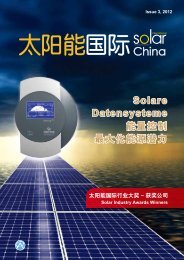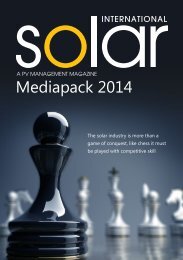A clearer road ahead
A clearer road ahead - Solar International Magazine
A clearer road ahead - Solar International Magazine
- No tags were found...
Create successful ePaper yourself
Turn your PDF publications into a flip-book with our unique Google optimized e-Paper software.
INDUSTRY I OPINION<br />
Solar produces affordable and clean energy and thus<br />
creates the jobs and opportunities that will sustain the growth of<br />
the European green economy. The future path to success and<br />
competitiveness of solar energy, however, is currently at stake:<br />
Some European solar manufacturers try to gain individual<br />
advantages in the current industry crisis by calling for<br />
protectionist measures against Chinese competitors. This attempt<br />
to protect markets from competition does not do the European<br />
solar industry any service. Just the contrary – protectionist<br />
measures would set in motion a process that would be<br />
disastrous for all the parties involved.<br />
Throughout the world subsidy cuts, excess capacity and<br />
pressure on prices are creating problems for the manufacturers<br />
of solar modules in particular. The challenges that European<br />
module producers are facing in this market situation, however,<br />
have not been caused by the foreign competition. Rather, many<br />
European solar producers have focused their business<br />
strategies too narrowly on a few European markets and their<br />
attractive public support – which helped mainly German<br />
manufacturers to grow their companies in the first instance and<br />
to reach leadership positions in the young solar industry. But in<br />
the longer run, these companies have been lacking a strategy<br />
beyond the mere reliance on the benefits from the system. Many<br />
of them simply have failed to adapt their business models fast<br />
enough to the changing market environment.<br />
In the last ten years, the solar market has experienced a very<br />
substantial change. It originally was a dealer and distributorfocused<br />
business, based on selling to the installers who more or<br />
less served the rooftop market. This was where the strength of<br />
the German and European module manufacturers lay, and what<br />
they designed their production plants for. But the old business<br />
model has changed and moved towards an EPC-driven<br />
approach with a focus on large installations and groundmounted<br />
systems. What used to be the main area of sales,<br />
today merely represents a fraction of what it used to be years<br />
ago. Most EU solar manufacturers have not been able to change<br />
in accordance with the trend. They have failed to invest in<br />
innovation and efficiency and did not increase their capacities<br />
when the market demanded it, as the costs for the raw material<br />
silicon fell. Later, when those enterprises tried to close the<br />
development gap between them and the Chinese producers, the<br />
necessary investments were not bearable for them. This<br />
development is also reflected in the undersized production<br />
capacities of many European producers. Today, the market is<br />
dominated by players who can produce 2 to 3 Gigawatts per<br />
year – and none of them are based in Europe.<br />
A truly global value chain<br />
Trade barriers might alleviate the current crisis symptoms of the<br />
industry in Europe in the short term by temporarily providing<br />
solar cell manufacturers with a competitive advantage. In the long<br />
term, however, this would not cure the actual malady of the<br />
sector, but would increase the price of PV systems, dampen<br />
demand and thus create even greater challenges to the<br />
European market. This is also due to the global and<br />
interconnected nature of the supply chain for photovoltaic<br />
products, in which components from different countries and<br />
Figure 1: Prices per Watts peak have been continuously declining.<br />
(Source: The Alliance for Affordable Energy))<br />
continents are assembled into one end product. To speak about<br />
the domination of companies from one specific country is<br />
misleading, as this only focuses on where the module is<br />
assembled and ignores the steps that happen before and after in<br />
the global solar value chain.<br />
If one looks at each element that contributes to a PV system, a<br />
high degree of international collaboration is evident. For instance,<br />
the United States has one of the largest known deposits of quartz.<br />
Quartz crystals are used in reaction chambers and tools applied in<br />
the manufacturing process of silicon wafers, solar cells and finally<br />
the PV module. The largest producers of polysilicon come from<br />
Germany and Japan, and also the largest producers of<br />
manufacturing equipment and inverters are German. Finally, it’s<br />
the local project developers, engineers and installers who are<br />
responsible for the set-up and maintenance of PV power plants<br />
that benefit from this global contribution.<br />
The fact is that even if a solar panel is produced in China, about<br />
70 percent of the total value creation is generated inside Europe.<br />
If protectionist measures impact on one part of this value chain,<br />
the consequences therefore spread far beyond this, finally<br />
Figure 2: Domestic and foreign content of solar rooftop system<br />
in Germany, 2012 and 2012. Created by Petite Planète<br />
(Source: Heinrich-Böll-Stiftung)<br />
Issue IX 2012 I www.solar-international.net 15








